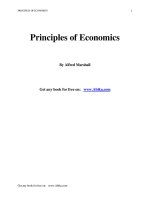Principles of economics openstax chapter10
Bạn đang xem bản rút gọn của tài liệu. Xem và tải ngay bản đầy đủ của tài liệu tại đây (203.76 KB, 35 trang )
MONOPOLISTIC COMPETITION AND OLIGOPOLY:
IMPERFECT COMPETITION
DR. RICHARD GEARHART
ENTERPRISE COLLEGE
06/20/2016
NOTES, DEFINITIONS, AND BASICS
Total Revenue (TR): the total amount of money earned by selling a certain amount of
good.
TR = P * Q
Marginal Revenue (MR): the additional revenue earned from producing, and selling, an
additional unit.
∆TR TRQ − TRQ−1
MR =
=
= TRQ − TRQ−1 = ∆TR
∆Q ( Q) − ( Q−1)
Total Cost (TC): the total costs of producing a certain amount of units.
Marginal Cost (MC): the additional costs of producing an additional unit of the good.
MC =
∆TC TCQ − TCQ−1
=
= TCQ − TCQ−1 = ∆TC
∆Q ( Q) − ( Q−1)
Average Cost (AC): the cost per unit of producing a certain number of goods.
TC
AC =
Q
Quantity
Price
Total Revenue
Marginal
(P*Q)
Revenue
Total Cost
Marginal Cost
0
10
= (0)(10) = 0
-
0
-
1
9
= (1)(9) = 9
=9–0=9
5
=5–0=5
2
8
16
= 16 – 9 = 7
10
= 10 – 5 = 5
3
7
21
= 21 – 16 = 5
15
= 15 – 10 = 5
4
6
24
3
20
5
5
5
25
1
25
5
6
4
24
-1
30
5
7
3
21
-3
35
5
8
2
16
-5
40
5
Demand Curve: one way to view the demand curve is that each point on the demand curve
represents a consumer’s maximum willingness to pay for that unit of the good.
•
At point A (a price of 10 and a quantity of 1), the maximum the consumer is willing to pay (WTP) for the 1
$10.
•
At point B, the maximum WTP, by the consumer, for the 2
•
At point C, the maximum WTP, by the consumer, for the 3
nd
rd
unit is $9.
unit is $8.
st
unit of the good is
WHERE DO ALL FIRMS PRODUCE?
A firm will produce up until the point where it earns no additional profits from producing.
This means that the firm will produce until its marginal profit (the additional profit from
producing and selling one more good) is equal to 0.
PROFIT = TR− TC
∆PROFIT = ∆TR− ∆TC
0 = ∆TR− ∆TC
∆TR = ∆TC
MR = MC
•
Thus, all firms will produce (regardless of market structure) where:
MR = MC
•
If MR is greater than MC, this means that the additional revenues from producing outweigh the additional costs. You earn higher
profits by producing, and should continue to produce MORE.
•
If MR is less than MC, this means that the additional revenues from producing are outweighed by the additional costs. You lower
your profits by producing, so produce LESS.
MONOPOLISTIC COMPETITION
Monopolistic competition is a market structure where there are many firms.
Each firm produces a slightly differentiated (heterogeneous) good.
Big Mac vs. Whopper
Coke vs. Pepsi
Nike vs. Reebok
Polo vs. J Crew
In monopolistic competition, brand differentiation is of paramount importance.
Brand differentiation allows one firm to price their comparable good differently than another
firm.
These comparable goods are known as substitutes.
Brand differentiation is created through a variety of means.
Advertising
Quality
Brand loyalty (Apple)
Innovation
Customer Service
Product Support
Warranty
…
A monopolistically competitive firm has more pricing power than a perfectly competitive
firm.
Because the products are slightly differentiated.
A monopolistically competitive firm has less pricing power than a monopolist.
Because there are several firms in the market.
PRICING POWER refers to the ability, by a firm, to raise prices by restricting how much they
produce.
By restricting how much you produce and sell, you make a good scarce (rare). People are willing to
pay a lot of money for rare items.
Diamonds
Collectibles
…
•
In perfect competition (green demand curve), the firm has no pricing power. If it cuts quantity, it cannot raise prices.
•
In monopoly (red demand curve), the firm has absolute pricing power. If it cuts quantity, because no other firm produces
anything similar, it can raise prices dramatically.
The monopolistically competitive firm produces where MR = MC. This is shown at point A.
We therefore produce 20 units of the good (QA). Because of what the demand curve
represents (i.e., the maximum WTP by each consumer), the monopolistically competitive
firm will price up to the demand curve (point B), which is a price of $15 (PA).
Quantity
Price
Total Revenue
Marginal
(P*Q)
Revenue
Total Cost
Marginal Cost
Profits (TR –
TC)
0
10
= (0)(10) = 0
-
0
-
=0–0=0
1
9
= (1)(9) = 9
=9–0=9
5
=5–0=5
=9–5=4
2
8
16
= 16 – 9 = 7
10
= 10 – 5 = 5
= 16 – 10 = 6
3
7
21
= 21 – 16 = 5
15
= 15 – 10 = 5
6
4
6
24
3
20
5
4
5
5
25
1
25
5
0
6
4
24
-1
30
5
-6
7
3
21
-3
35
5
-14
8
2
16
-5
40
5
-24
In monopolistic competition, competitors produce close substitutes.
Coke vs. Pepsi
Big Mac vs. Whopper
If I am a monopolistically competitive firm, and I am making positive economic profits,
other firms will want to enter the market to capture some of these profits.
Capture the profits by providing substitutes (alternatives) to the product that I am producing.
When a monopolistically competitive firm earns positive economic profits, new firms enter
the market, reducing the demand for my product. This lowers the price that I can charge AND
reduces the amount sold.
This reduces my profits.
Because I was earning positive economic profits, new firms enter, reducing the demand for my
product from D0 to D1. This reduces the price that I charge, from $15 to $10. It also reduces the
quantity that I sell, from 20 to 10.
Equilibrium has moved from point A to point B.
In the long-run, monopolistically competitive firms earn ZERO ECONOMIC PROFITS.
An economic profit is where you, as a CEO, still receive pay (income), but you don’t earn
additional money to re-invest in your company.
Another way to think about an economic profit is that it is a “bonus” that you earn at the end of
the year because you have extra money.
Where does a firm earn no economic profits?
PROFIT = TR− TC
0 = TR− TC
0 = P *Q− TC
P *Q = TC
TC
P=
Q when the price for each unit of the good is equal to
A firm will earn ZERO economic profits
how much, on average, the unit costs to produce.
P = AC
If each unit costs, on average, $5 to produce, I need to receive $5 for that unit to break even.
OLIGOPOLY
An oligopoly is a very few, large, firms in a market, that have most of the sales.
They typically produce very similar goods (substitutes).
Mass produced sodas.
Auto industry
Airlines
Oil companies
There is tremendous interdependence in an oligopolistic market.
How much each firm produces, what price each firm charges, the quality of the product, the amount
of advertising, all change based on what other firms are doing.
For example, if Exxon decides to initiate a large-scale, advertising campaign, it is likely that other
large oil producers (Chevron, Halliburton) will follow suit.
Interdependence occurs because, since each firm is so large, they can quickly exploit any
differences between them and other firms, and gain rapid market share.
Think about the quality of cars. They are roughly the same (for the major, economy-brand
manufacturers) because, if one brand suffers from low quality, other car companies will rapidly
exploit this.
If oligopolies have interdependence, will they collude (work together to maximize market
profits for ALL firms) or will they compete (work against each other to maximize individual
profits for a firm)?
Several types of ways that firms can compete.
Price (Bertrand competition)
Quantity (Cournot competition)
Entry into a new product market (Stackelberg competition)
Requires GAME THEORY; this is strategic interaction between people/firms/governments (any
economic actor).
COMPETITION OR COLLUSION
Known as the Prisoner’s Dilemma.
Shows why collusion is very hard.
Essentially, in the short-run, firms will benefit by agreeing to work in tandem, and
then by breaking their word.
PRISONER B
PRISONER A
COOPERATE WITH OTHER
CONFESS (SNITCH ON OTHER
PRISONER
PRISONER)
A gets 5 years, B gets 5 years
A gets 15 years, B gets 3 years
A gets 3 years, B gets 15 years
A gets 10 years, B gets 10 years
COOPERATE WITH OTHER
PRISONER
CONFESS (SNITCH ON OTHER
PRISONER
What Should Prisoner B Do?
•
•
•
Suppose that Prisoner A will cooperate. Then, B should confess (3 years from confessing is better than 5 years from cooperating).
Suppose that Prisoner A will confess. Then, B should confess (10 years from confessing is better than 15 years from cooperating).
No matter what Prisoner A does, Prisoner B will confess.
•
We get the SAME result from looking at what Prisoner A should do.
•
Even though there is a better option (cooperating with each other), both will confess, and get 10 years.
•
The reason this occurs is because of the fact that if one prisoner is “stupid” and continues to cooperate, the other, by
confessing, will benefit and get very few years (3 years).
The Prisoner’s Dilemma states that, if you cannot force someone to cooperate with you (a
contract or some other “enforcement” mechanism), then their best option is to snitch.
Therefore, your best option is to snitch.
Without “enforcement”, collusion WILL NOT occur.
NATO/UN work because there are enforcement mechanisms in place.
OPEC works because there is an enforcement mechanism in place (if you decide to produce more,
then all countries will produce more to drive the price down, hurting the country that broke the
“contract”).
One way to create an enforcement mechanism is through manipulation of production.
Suppose there is a cartel (a collection of firms that collude).
Suppose that one member of the cartel (Coca-Cola) decides to break their agreement.
If Coca-Cola wants to produce a few more units, then all firms in the cartel agree to massively
increase production so that the price rapidly drops.
If Coca-Cola wants to raise prices a little bit, it will cut production. All other firms will not change
their behavior, so that the price does not increase that much.
In both cases, total revenues for the firm that has broken the agreement will fall.









